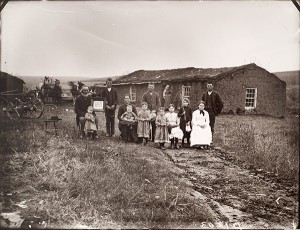Collage Art- Third & Fourth Grade
Lesson Overview:
Students will become familiar with 19th century Nebraska history and discover what it would be like to live as a pioneer on the Nebraska Plains, and become familiar with the struggles of life on the Plains by viewing and discussing various artworks. Students will create a mixed-media collage including photographs of them and their families in a rural environment during the 1800s. To conclude the lesson, students will write a short story describing a day as a pioneer as they each depicted in their collage.
Lesson Objectives:
Students will make a connection between art and other disciplines by exploring pioneer life as interpreted by artworks and creating a short story of their life as a pioneer.
Students will understand art in relation to history by exploring the manner in which artists portray 19th century life on the Plains through their art and then placing images of themselves in their own artworks.
Students will understand and apply media and techniques as well as demonstrating knowledge of structures and functions by successfully creating a multi-media collage.
Students will reflect on and assess their work and the work of others by sharing and discussing their artworks with their classmates.
Instructional Procedures/Sequence:
- Discuss Nebraska history and what it would have been like to live as a pioneer after viewinghttp://www.nebraskastudies.org/.
- Ask students to create their own artwork consisting of a mixed-media collage including images of them and their families.
- Have the students write a short story about a day in their life as a pioneer on the Nebraska Plains as they each depicted in their collage.
- To conclude the lesson, have students share their artwork and story with their classmates.
Vocabulary:
immigrant
ancestor
generation
treaty
culture
diversity
pioneer
sodbuster
Materials Needed:
construction paper and poster board, burlap, fabric, yarn, objects found in nature, photographs, paint, markers, oil pastels, glue, and scissors.
National Visual Art Standards Addressed:
- Understand and apply media, techniques, and processes.
Achievement Standard:- know the differences between materials, techniques, and processes.
- use different media, techniques, and processes to communicate ideas, experiences, and stories.
- use art materials and tools in a safe and responsible manner.
- Use knowledge of structures and functions.
Achievement Standard:- know the differences among visual characteristics and purposes of art in order to convey ideas.
- use visual structures and functions of art to communicate ideas.
- Understand the visual arts in relation to history and cultures.
Achievement Standard:- identify specific works of art as belonging to particular cultures, times, and places.
- Reflect on and assess the characteristics and merits of student’s work and the work of others.
Achievement Standard:- understand there are various purposes for creating works of visual art.
- describe how people’s experiences influence the development of specific artworks.
- understand there are different responses to specific artworks.
- Make a connection between visual arts and other disciplines.
Achievement Standard:- identify connections between the visual arts and other disciplines in the curriculum.
Accommodations/Modifications:
Students with special needs should be evaluated by their teachers to determine which accommodations will work best for the student.
More Lesson Plans
Understanding the Basic Groups of Animals, Science – Second grade
Native Americans on the Plains, History – Fourth grade
Fundamentals of Design through Art, Family Consumer Science – Secondary level










